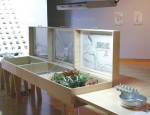Bringing life to art

What if art could grow flowers? What if it could change the landscape of an entire city?
Though believing such a thing might require a stretch of the imagination, Torolab’s One Degree Celsius exhibit, on display at the Contemporary Art Museum (CAM), intends to plant the seeds of change in the back of everyone’s mind.
Raul Cardenas Osuna founded the Tijuana-based art collaborative Torolab in 1995 in an attempt to use art to transform communities around the world.
In 2001, the collective of artists, architects and designers caught the attention of CAM curator Izabel Galliera with Vertex, a plan to make the crossing of the U.S.-Mexico border a more comfortable experience than it has been in the past.
“I contacted the artists from Torolab in December of last year,” Galliera said. “Their project on the Mexican border intrigued me, and I thought that this is something I would love to bring to the University.”
Galliera worked with Torolab on its latest exhibit, One Degree Celsius. It is the second in a series of projects Osuna calls “molecular urbanism,” a term the artist coined to describe the converting of urban habitats into more livable places, thus leaving a positive impact on the environment for years to come. This installment of molecular urbanism is being presented as a study of the different uses of a garden and what effects it can have on the human psyche.
To get it all started, Galliera and Osuna took a drive. They made their way through places such as downtown Tampa and Ybor City, taking pictures of areas they considered to be lifeless.
“We were very concerned with the predominant presence of large parking lots and lack of pedestrian life,” Galliera said. “Those places were quiet and not active. They just weren’t places people wanted to be.”
From the shots they had taken, Osuna drew up sketches of what the areas would look like spruced up with various indigenous plants.
Those sketches — along with some plans to beautify USF — will all be on display in the first section of One Degree Celsius. Visitors to the museum can also observe a series of potted plants exhibiting the life cycle of the species Osuna hopes city officials will consider using to create gardens around the area.
Don Fuller, CAM’s curator of new media, stresses that Torolab does not mark the beginning of this project, but the beginning of a greater conversation.
“Torolab isn’t a plan that’s been decided on or something that is already happening,” Fuller said. “The people involved in Torolab aim to get a discussion going about how we can improve our quality of life.”
The exhibit at CAM will include a screening area for socially conscious films, all three of which take a further look at projects that share Torolab’s philosophy of art as a catalyst for change.
Though One Degree Celsius opened its doors to the public on Monday, Alexa Favata, associate director of the Institute for Research in Art, said the real conversation will occur at Torolab’s colloquium on Sept. 14, in the Marshall Student Center. The event will feature guest speakers from around the continent, founder Osuna, accomplished artist and published author Alan Moore, and Laurie Palmer, chair of sculpture at the School of the Art Institute of Chicago.
“We’ve invited members of (the) city council, officials from universities around the country and all members of the community to attend,” Favata said. “Torolab is an idea, but it’s up to members of the community to get involved if we want to see any of this become a reality.”
For more information on Torolab or to watch the recording of the colloquium, visit the Institute of Research in Art’s Web site at ira.usf.edu.





